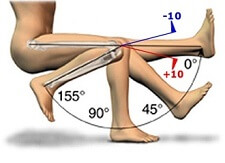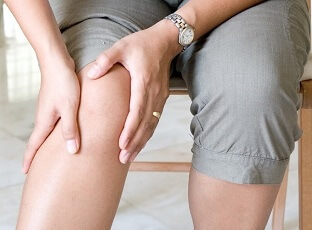- Home
- Knee Pain Diagnosis
- Pain Below Knee
Pain Below Knee
Written By: Chloe Wilson, BSc(Hons) Physiotherapy
Reviewed by: KPE Medical Review Board
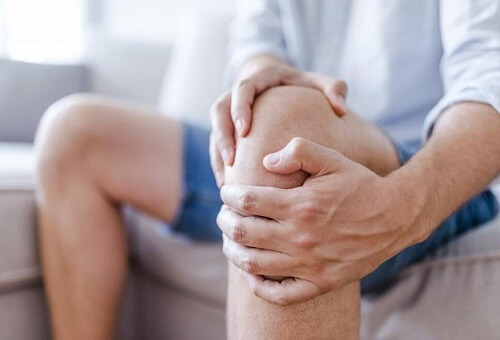
Pain below the knee is a common problem that may come on suddenly with an injury, or gradually over time.
There may be a sharp pain below the knee, a more generalised, dull ache, instability, stiffness or locking.
Symptoms may be quite localised with pain just below the knee or extend further down in the lower leg into the shin or calf.
Pain under the knee is often accompanied by swelling below the knee which may be quite localised or more generalised around the whole knee.
Causes Of Below Knee Pain
Here we will look at the most common causes of pain below the knee, what causes them, common symptoms and how to treat them. We will also look at how to work out what is causing your pain under the knee by thinking about your symptoms and what activities are affected.
1. Patellar Tendonitis
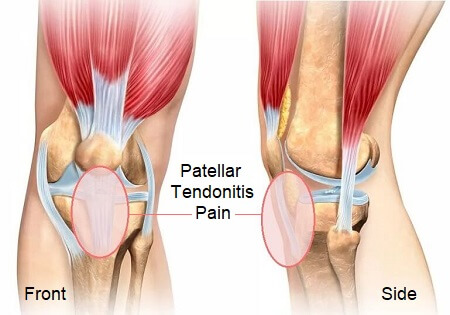
The most common cause of pain below the knee is patellar tendonitis, aka Jumper’s Knee.
With patellar tendonitis, there is inflammation and degeneration of the patellar tendon that sits just below the kneecap.
The patellar tendon connects the quads muscles to the shin bone (tibia).
Patellar tendonitis causes tenderness and pain just below the knee which typically gets worse with activities such as running, jumping and squatting. There may be some thickening in the tendon and the knee often feels stiff in the morning and after activity.
Jumper’s knee is typically an overuse injury caused by repetitive activities such as jumping and kicking. Overtraining, muscle imbalance and bone spurs all increase the risk of developing pain below the knee from patellar tendonitis.
You can find out all about this common cause of pain just below the knee including the causes, symptoms and treatment options in the Patellar Tendonitis section.
2. Osgood Schlatters Disease
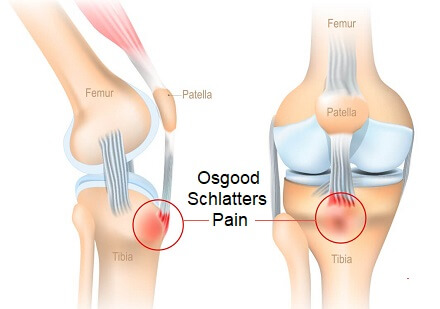
The most common cause of below knee pain in adolescents is Osgood Schlatter Disease (OSD).
Pain below the knee from Osgood Schlatters often develops following a growth spurt, where the bones grow quicker than the muscles can stretch.
Tightness in the quads muscles puts excess tension through the patellar tendon, pulling on its attachment to the shin bone at the tibial tuberosity. This tension causing inflammation and irritation at the tibial tuberosity which can lead to small cracks in the bone or bone spur formation.
Osgood Schlatters Disease causes tenderness and pain under the knee that gets worse with activities such as kicking and jumping. Overtime, a hard bony lump forms on the front of the shin, about 2cm below the kneecap. Osgood Schlatters typically only affects one knee, but can occasionally affect both.
You can find out all about OSD, how it causes pain below the knee and how to treat it in the Osgood Schlatters Disease section.
3. Knee Bursitis
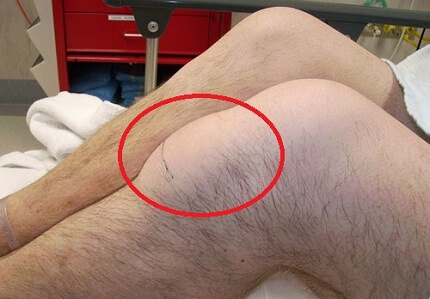
The most common cause of swelling and pain below the knee is bursitis.
Around the knee there are a number of bursa, small fluid-filled sacs that sit between bones and soft tissue to reduce friction.
If there is repetitive pressure or friction on one of the bursa, it becomes inflamed and fills with excess fluid, forming a pocket of swelling. Knee bursitis swelling is usually quite defined and often resembles a squashy orange.
The two most common types of bursitis that cause swelling and pain under the knee are:
- Infrapatellar Bursitis: causes swelling and pain just below the knee cap at the front of the knee
- Pes Anserine Bursitis: causes swelling and pain under the knee on the inner side
Bursitis usually develops when there is repetitive pressure through the bursa e.g. frequent kneeling, repetitive friction e.g. sports involving kicking and jumping, muscle tightness or a direct blow to the knee e.g. car accident or sporting tackle.
You can find out all about bursitis swelling and pain under the knee and the common causes, symptoms and best treatment options in the Knee Bursitis section.
4. Plica Syndrome
Another possible cause of pain under the knee that often goes undiagnosed is plica syndrome.
With plica syndrome there is irritation and inflammation in the knee plica, folds in the synovial membrane of the joint capsule that surrounds and lines the knee joint.
Infrapatellar plica syndrome causes a dull achy pain below the knee that gets worse at night or when bending and straightening the leg e.g. going up and down stairs or squatting. There may also be a feeling of knee instability and in some cases a catching/locking sensation with knee movement, which may become restricted.
Plica syndrome develops when the knee plica get trapped or pinched. This may be from a direct blow to the knee, repetitive knee bending/straightening e.g. running & cycling, sudden increases in activity levels, muscle weakness or an underlying knee condition or injury.
You can find out everything you need to know about knee plica pain below the knee, the common causes, symptoms and treatment options in the Plica Syndrome section.
5. Patellofemoral Pain Syndrome
Another possible cause of pain below the knee and around the kneecap is patellofemoral pain syndrome, aka Runner’s Knee.
Patellofemoral pain syndrome develops when there is repetitive excess stress on the thick layer of cartilage that lines the back of the knee cap.
This causes an ill-defined aching pain below the knee cap that gets worse with prolonged activity e.g. long distance running or skiing, coming down stairs or after sitting for prolonged periods. It is just as likely to affect office workers as runners!
Anything which affects how the kneecap glides up and down, known as patellar tracking, can result in pain under the knee cap from patellofemoral pain syndrome. Common causes include muscle weakness and tightness, abnormal foot biomechanics e.g. flat feet, and having a wide hip angle.
You can find out all about this cause of pain below knee cap and the best ways to treat it in the Runners Knee section.
Other Possible Causes
So far we have looked at the most common causes of pain just below the knee but there are a few other possible causes of leg pain below the knee, some of which may extend further down the shin towards the ankle.
1. Osteochondritis Dissecans
Osteochondritis Dissecans is one of the rarer causes of pain below the knee, where loose fragments of bone and cartilage break off at the knee joint due to a poor blood supply. Osteochondritis causes a vague, achy pain under the knee with occasional sharp, catching pains and locking if a bone fragment has broken off and gets stuck in the joint.
You can find out all about the causes, symptoms and treatment options in the Osteochondritis Dissecans section.
2. Tibial Stress Syndrome
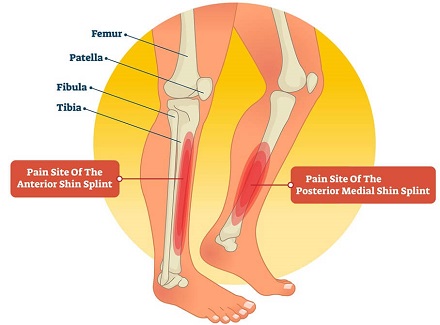
Tibial stress syndrome, aka shin splints, are a common condition characterized by leg pain below the knee along the front or inner side of the shin bone (tibia).
Shin splints are often caused by repetitive activities like running or jumping, leading to inflammation of the muscles, tendons, and periosteum (connective tissue covering the bone) in the shin area.
Rest, ice, proper footwear, stretches and gradual return to activity are usually recommended for recovery.
3. Nerve Pain
Pressure or irritation of one of the nerves, anywhere along its course from the spine down the leg, is a common cause of leg pain under the knee.
Nerve pain in the lower leg is usually described as a burning or shooting pain and is often accompanied by tingling, numbness and weakness in the knee and foot. It may or may not be accompanied by back pain.
You can find out all about how nerve and spine problems cause leg pain and how to treat them in the Nerve Pain section on our sister site.
4. Calf Tear
Pain below the knee in the back of the calf from a tear in one of the calf muscles is a common sporting injury. Calf tears occur when the muscle is over-stretched or overloaded, damaging the muscle fibres. Calf tears usually occur suddenly when quickly accelerating or changing direction. Weakness and tightness in the calf muscles make it more prone to tearing.
You can find out all about the causes, symptoms, diagnosis and treatment in the Calf Muscle Tear section.
5. Muscle Cramps
Sudden tightness, spasming and pain below the knee in the calf region is usually caused by muscle cramps, where one of the muscles contracts involuntarily and won’t relax. Cramping may be caused by muscle fatigue if the muscle has been overworked, underlying medical conditions e.g. peripheral neuropathy or liver disease, dehydration or electrolyte imbalance.
Leg muscle cramps can be really painful and may last from anything from a seconds to a few hours. In most cases, muscle cramps settle down quickly and are usually completely harmless.
You can find out all about this common cause of leg pain below the knee and how to treat and prevent it in the Calf Cramps section.
6. Tibialis Anterior Tendonitis
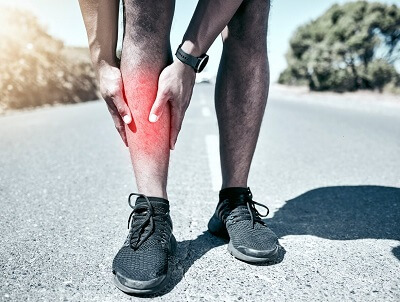
Front leg pain below the knee towards the ankle is often due to tibialis anterior tendonitis.
Overuse of the tibialis anterior muscle, which pulls the foot up so we don’t trip over our toes as we walk and run, leads to pain, inflammation and micro-tearing in the tendon.
Tibialis anterior tendonitis often affects athletes who do lots of repetitive movements e.g. running, jumping and dancing, particularly if they have flat feet or don’t wear supportive footwear. Muscle imbalance, aging and training errors all increase the risk of lower leg pain from tendonitis.
You can find out all about the common causes, symptoms, diagnosis and treatment options in the Tibialis Anterior Tendonitis section on our sister site.
7. Achilles Tendonitis
Leg pain below the knee in the lower calf is often due to Achilles tendonitis. This is where there is inflammation and degeneration in the Achilles tendon which connects the calf muscles to the heel bone. Pain from Achilles tendonitis can be felt anywhere from about half way down the back of the calf to the heel. There may be a palpable hard, tight knot in the Achilles tendon.
Achilles tendonitis is usually caused by excessive stress through the tendon from over-activity or sudden increases in activity levels, tension from muscle tightness and weakness or friction from bone spurs.
Leg pain below the knee from achilles tendonitis can take a long time to settle down as the tendon has a poor blood supply which delays healing. You can find out all about the common causes, symptoms, diagnosis and treatment options in the Achilles Tendonitis section on our sister site.
8. Vascular Problems
Leg pain below the knee may also be caused by a disruption to the blood flow in the lower leg from:
- DVT: blood clot in the lower leg veins that causes intense pain, swelling, warmth and redness. A DVT is a medical emergency requiring urgent treatment
- Peripheral Artery Disease: caused by narrowing or a blockage in the blood vessels in the leg which causes leg pain, cramping, or weakness during physical activity (intermittent claudication), numbness or tingling, coldness or discoloration of the legs or feet and weak or absent foot pulses.
Pain Below Knee Treatment
Treatment for pain below the knee will depend on the underlying cause of the problem but will usually involve a combination of:
- PRICE: protect, rest, ice, compression and elevation. This helps to reduce pain and inflammation, reduce the risk of further damage and speed up the healing process
- Medications: over-the-counter painkillers and anti-inflammatories can help to reduce inflammation and pain below the knee. Always check with your doctor or pharmacist before taking new medications
- Strengthening Exercises: Strengthening the knee muscles and calf muscles helps to reduce the forces going through the different knee structures and improves the stability, strength and control around the knee. Knee strengthening exercises will form part of most rehab
programs for pain below the knee - Knee Stretches: Stretching out the different knee and calf muscles helps to reduce tension and tightness which helps to off-load the knee structures. A combination of quads stretches, hamstring stretches and calf stretches is usually most effective
- Knee Braces: wearing a knee brace during exercise can help to support the knee and reduce the forces going through the joint. Knee straps are an excellent tool for off-loading affected structures, and are particularly useful with patellar tendonitis
- Injections: knee injections can help reduce inflammation and pain below the knee. A mixture of anesthetic and corticosteroid is injected into the affected area e.g. knee joint or tendon. The effects can last anything from a few days to a few months but injections do temporarily weaken tendons so it is important to take things easy for a few days
- Orthotics: pain below the knee is often linked to altered foot biomechanics e.g. flat feet, so wearing special inserts in your shoes to correct your foot position can really help
- Physical Therapy: a physical therapist can work on a rehab program with you as well as providing hands-on treatment such as ultrasound, taping and massage
- Surgery: in some cases, your doctor may advise surgery for your pain below the knee if you have failed to respond to treatment or the injury is more severe
Pain Below Knee Diagnosis
Thinking about the activities that cause pain below the knee, or where exactly the pain is can really help with working out what is wrong:
- Pain Below Knee Inside: pain just below the inner side of the knee is usually due to plica syndrome, an MCL injury, medial meniscus tear or pes anserine bursitis. If there is inner leg pain under the knee, it may be from shin splints or tibialis anterior tendonitis
- Pain Below Knee Outside: pain just below the outer side of the knee may be caused by lateral plica syndrome, LCL sprain, a lateral meniscus tear or ITB syndrome
- Pain In Bone Below Knee: is usually caused by osgood schlatters (hard lump on front of shin), shin splints or a fracture
- Pain Under Knee When Running: usually aggravates overuse injuries such as patellar tendonitis, osgood schlatters, runner's knee or tibialis anterior tendonitis
- Pain Under Knee When Bending: if the pain below your knee gets worse when you bend your leg, you may have runner's knee, bursitis, patellar tendonitis, plica syndrome or osgood schlatters
- Sharp Pain Below Knee: if you get a sharp pain under the knee, it may be from knee bursitis, nerve damage, osteochondritis dissecans or a calf tear
- Burning Pain Below Knee: if there is a burning sensation under the knee it may be a sign of nerve damage, knee bursitis, gout knee or a vascular problem
- Numbness Below Knee: if the area below the knee feels numb or has reduced sensation or tingling, then there is most likely some nerve damage somewhere along the path of the nerve between the back and where the pain is being felt
Pain Under The Knee Summary
Pain below the knee is a common problem. There may be pain right below the knee cap, on the inner or outer side of the knee or leg pain below the knee in the shin or calf.
Below knee pain is often due to overuse and overloading of the different knee structures which leads to inflammation, degeneration and pain.
There may be associated symptoms such as instability, stiffness, swelling, locking, and functional limitations e.g. difficulty getting up and down stairs alongside pain under the knee.
Treatment for below knee pain often involves a combination of PRICE, exercises, knee braces, orthotics, physical therapy and in some cases injections or surgery.
If you have significant swelling associated with your pain under the knee, then check out the swelling below the knee section. Or if you want help working out what is cause your pain below the knee, visit the knee pain diagnosis section.
You may also be interested in the following articles:
- Front Knee Pain
- Top Of Knee Pain
- Pain Behind The Knee
- Sharp Knee Pain
- Burning Knee Pain
- Knee Pain On Stairs
- Knee Pain At Night
Page Last Updated: 22/06/23
Next Review Due: 22/06/25
